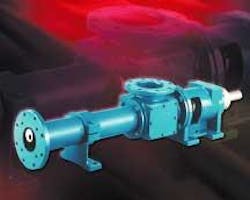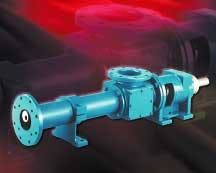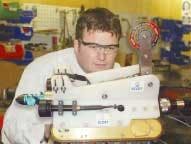New Products & Services
Jaime Kammerzell • Gulf of Mexico Editor
Locking fasteners
STAGE 8 Locking Fasteners Inc., www.stage8.com, manufactures an active mechanical fastener locking system designed to stop joint failure/production downtime by preventing thread loosening from starting. Essentially, its patented GrooveLok fastener locking system acts like a small wrench locked onto a bolt head, with the wrench handle braced against a stationary object, such as a frame, casting, or protrusion, the company says. This stops any counter rotation of the bolt, and thus bolt loosening, until the locking system is removed.
Air filtration system
Donaldson Co. Inc., www.donaldson.com, has a gas turbine intake air filtration system that provides high-velocity, four-stage filtration to remove dirt and salt particulate and water droplets from the airstream that feeds the turbine. Salt particles in particular are corrosive and cause pre-mature wear on compressor blades. The Donaldson GTM housing is all stainless steel and the filter elements are metal-free to resist corrosion in harsh, oceanic environments.
Cavity pumps
Moyno progressing cavity pumps provide performance-enhancing benefits in upper- and lower-deck FPSO applications. The pumps are capable of handling clean and oily liquids as well as corrosive fluids and thick, abrasive slurries and sludges, even with viscosities over 1,000,000 cps, the company says. The product line includes models capable of generating flow rates up to 2,500 gpm and pressures to 2,100 psi. Moyno pumps are known for low maintenance, dependability, and long service life, the company says, which result in low overall total cost of ownership in both top-side and hull-side applications. Their high-performance, progressing cavity design results in a gentle, low shear, pulsation-less discharge.
Stabilizer for bi-center drill bits
NQL Energy Services has developed a two bladed, full-hole stabilizer for bi-center drill bits. The V-Stab has no moving parts and is designed using bi-center geometry. Use of bi-center geometry allows the stabilizer to pass through a smaller hole, but stabilize the string in a larger hole, reducing the detrimental effects of string vibrations. Since the V-stab has two blades that are at the full hole diameter (the third blade is missing and does allow string movement to one side of the hole), string movement in the opposite direction is prevented. This reduces the effects of the string vibrations, and may result in longer bit runs, bit life, and increased ROP, the company says. Over 12 runs have been made with the V-Stab and the results have demonstrated improved ROP and significant improvements in bit life, the company says.
Thermal spray aluminum coating line
The Bayou Co. has a new automated thermal spray aluminum coating line. The TSA line can coat straight pipe 6 in. or more in diameter and up to 80 ft in length. TSA coatings protect steel and iron from corrosion. Tests confirm the effectiveness of metallized coatings over extended periods of time in a wide variety of aggressive environments, the company says. TSA is an environmentally safe coating that produces zero VOCs, has no cure time, and eliminates toxic waste disposal concerns. Metallizing provides maximum corrosion protection for steel, withstands high temperatures, and has a service life of up to 50 years, the company says.
Condensate re-circulation
The Energy Services Division of Nalco Co. has introduced a new condensate re-circulation process for lower-cost hydrate control in natural gas systems with high water production. In the past, it was necessary to have less than 80% water cut in natural gas wells for new generation, low-dosage hydrate inhibitors (LDHIs) to deliver optimum results. Nalco's new program uses platform infrastructure and proprietary application processes in combination with the Freeflow family of LDHIs to eliminate methanol usage in these types of wells, resulting in a 75% or higher overall cost reduction for hydrate mitigation, the company says. As part of the program, condensate is pumped through the pre-existing methanol injection system along with Freeflow LDHI.
Inspection robot
Aberdeen-based integrity, inspection, and corrosion company, iicorr Ltd., has designed a subsea inspection tool, the Trac-scan Crawler System, which inspects a horizontal 14-in. riser section for corrosion. The company created the crawler system to inspect out-of-reach sections with the use of an ultrasonic technique. The system incorporates a video camera and visual aid with the option of both video and digital-still capturing. It encompasses a 4 Mhz submersible probe incorporated into heli-scanner ultrasonic wall mapping tool, which allows for 100% ultrasonic measurements to be taken over a given area.
Orifice plate technology
Emerson Process Management says its conditioning orifice plate products deliver ±0.5% accuracy with only two diameters of straight pipe-run. The Rosemount 405 compact conditioning orifice plate and 1595 conditioning orifice plate enable users to extend the use of orifice plates into measurement points previously limited by existing piping configurations. These products deliver accurate and repeatable results downstream of a variety of flow disturbances that normally cause swirl in the flow process, the company says. The orifice plate technology consists of four equally spaced holes that condition the flow profile for a more stable, accurate measurement. Emerson says this unique design is the highest performing primary element available. The orifice plates require less straight run, significantly reducing material, labor, and procurement costs.
Downhole imaging tool
Norwegian subsea company Offshore Resource Group AS (ORG) has developed a new down hole imaging tool called VisuWel. The tool gives it's operator the ability to produce an accurate image of a target within wells. The environment in wells is normally prohibitive to the use of video cameras due to the presence of hydrocarbons, mud, etc., inhibiting the passage of visible light. The presence of gas bubbles, chaotic density, and temperature profiles also inhibits the use of acoustic technologies. Visuwell gives direct visual feedback without the need to disturb the status of the well. Consequently, the use of this tool will represent a significant cost and time saving with respect to well operations, ORG says.



